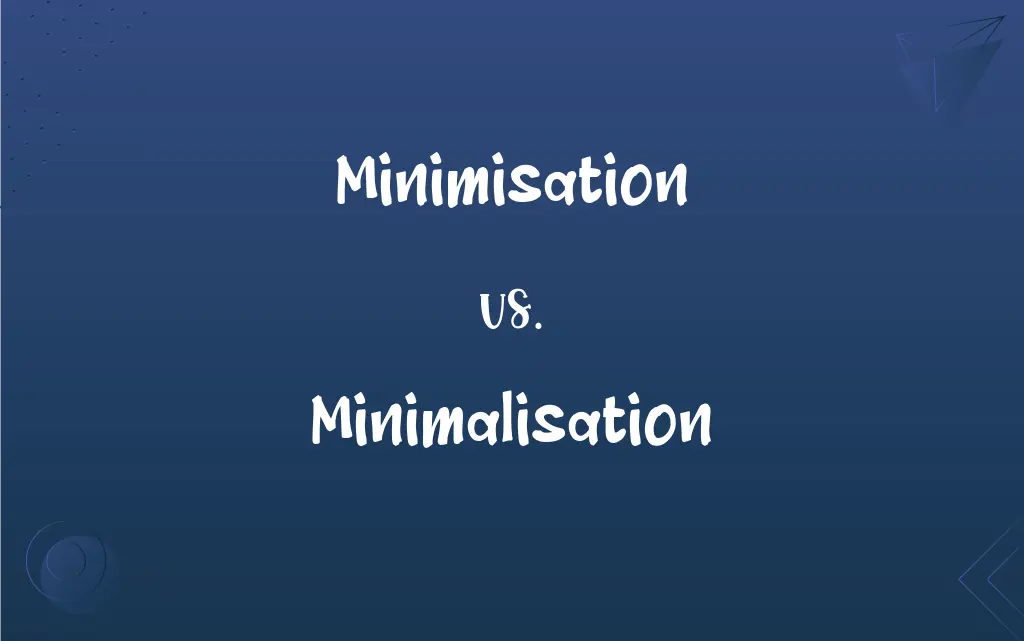Minimisation vs. Minimalisation: What's the Difference?
By Janet White & Harlon Moss || Updated on May 22, 2024
Minimisation is the process of reducing something to the smallest possible amount or degree. Minimalisation is the aesthetic and philosophical approach of simplifying and focusing on the essentials, often associated with minimalism.

Key Differences
Minimisation refers to the act of making something as small or as insignificant as possible. It is often used in contexts where reduction is necessary, such as minimizing risks, costs, or environmental impacts. Minimalisation, on the other hand, relates to the concept of minimalism, which is both an aesthetic style and a lifestyle philosophy. Minimalisation involves stripping down to the essentials, focusing on simplicity, and eliminating excess.
Minimisation is frequently used in technical, scientific, and business contexts where efficiency and effectiveness are prioritized. For example, companies might focus on the minimisation of waste or errors to improve productivity and sustainability. Minimalisation is more about the approach and philosophy behind the reduction. It involves a conscious effort to simplify and reduce to the bare essentials, often driven by an appreciation for simplicity and functionality. This can be seen in minimalist art, where the focus is on form and color, or in minimalist living, where individuals prioritize experiences over material possessions.
Minimisation is a practical process aimed at reduction, while minimalisation is an intentional practice rooted in minimalism, aiming for simplicity and essentialism.
Comparison Chart
Definition
Reducing something to the smallest possible amount
Simplifying and focusing on the essentials
Context
Technical, scientific, business
Aesthetic, philosophical, lifestyle
ADVERTISEMENT
Focus
Efficiency and effectiveness
Simplicity and essentialism
Application
Risk reduction, cost reduction, waste reduction
Art, design, personal living spaces
Outcome
Least possible amount or effect
Clean, uncluttered, essential-focused environment
Minimisation and Minimalisation Definitions
Minimisation
The act of reducing something to the smallest possible amount.
The company focused on the minimisation of production costs.
Minimalisation
The approach of simplifying and focusing on essentials.
Her minimalisation of the living room created a serene space.
ADVERTISEMENT
Minimisation
Making something as insignificant as possible.
The lawyer worked on the minimisation of the client's sentence.
Minimalisation
Adopting a minimalist aesthetic or lifestyle.
The artist's work is an exercise in minimalisation, using only basic shapes.
Minimisation
Process of decreasing size, amount, or impact.
The new policy aims at the minimisation of environmental damage.
Minimalisation
Emphasizing simplicity and functionality.
The minimalist kitchen design is a result of careful minimalisation.
Minimisation
Reducing waste and inefficiencies.
The factory implemented measures for the minimisation of resource use.
Minimalisation
Stripping down to the most necessary elements.
His wardrobe underwent minimalisation, retaining only essential clothing.
Minimisation
Reducing risk or harm to the lowest level.
Safety protocols are in place for the minimisation of workplace accidents.
Minimalisation
Reducing to core components for clarity and efficiency.
The book's minimalisation of complex ideas made it accessible to all readers.
Minimisation
Alternative spelling of minimization
Minimalisation
Alternative spelling of minimalization
Minimisation
Minimization.
Minimisation
The act of reducing something to the least possible amount or degree or position
FAQs
In what contexts is minimisation commonly used?
Minimisation is commonly used in technical, scientific, and business contexts.
What is minimalisation?
Minimalisation is an approach focused on simplifying and concentrating on essentials, often associated with minimalism.
In what contexts is minimalisation commonly used?
Minimalisation is used in aesthetic, philosophical, and lifestyle contexts.
What is minimisation?
Minimisation is the process of reducing something to its smallest possible amount or degree.
How do minimisation and minimalisation differ?
Minimisation focuses on practical reduction, while minimalisation emphasizes simplicity and essentialism.
What are examples of minimisation in business?
Examples include reducing costs, minimizing waste, and lowering risks.
What are examples of minimalisation in lifestyle?
Examples include decluttering living spaces and simplifying daily routines.
Can minimalisation be applied to interior design?
Yes, minimalisation is a key principle in minimalist interior design.
What is the goal of minimalisation?
The goal of minimalisation is to simplify and focus on the essentials, removing unnecessary elements.
Is minimisation always about quantity?
Yes, minimisation typically deals with reducing quantity or impact.
Can minimisation be applied to risk management?
Yes, minimisation is often applied to reduce risks in various fields.
What is the goal of minimisation?
The goal of minimisation is to achieve the least possible amount or effect of something.
Is minimalisation always about quality?
Minimalisation is about quality in terms of achieving simplicity and functionality.
Can minimisation and minimalisation be used interchangeably?
No, they have distinct meanings and are used in different contexts.
How does minimalisation enhance aesthetic appeal?
By focusing on simplicity and removing excess, minimalisation enhances aesthetic appeal.
Is minimisation a reactive process?
Minimisation can be both reactive and proactive, depending on the context.
How does minimisation improve efficiency?
By reducing waste and focusing on essential processes, minimisation improves efficiency.
Can minimalisation be applied to personal habits?
Yes, minimalisation can be applied to personal habits to simplify and improve daily living.
Is minimalisation a proactive practice?
Yes, minimalisation is typically a proactive practice aimed at simplifying and improving quality of life.
Can minimisation be applied to environmental practices?
Yes, minimisation is often applied to reduce environmental impact.
About Author
Written by
Janet WhiteJanet White has been an esteemed writer and blogger for Difference Wiki. Holding a Master's degree in Science and Medical Journalism from the prestigious Boston University, she has consistently demonstrated her expertise and passion for her field. When she's not immersed in her work, Janet relishes her time exercising, delving into a good book, and cherishing moments with friends and family.
Co-written by
Harlon MossHarlon is a seasoned quality moderator and accomplished content writer for Difference Wiki. An alumnus of the prestigious University of California, he earned his degree in Computer Science. Leveraging his academic background, Harlon brings a meticulous and informed perspective to his work, ensuring content accuracy and excellence.































































